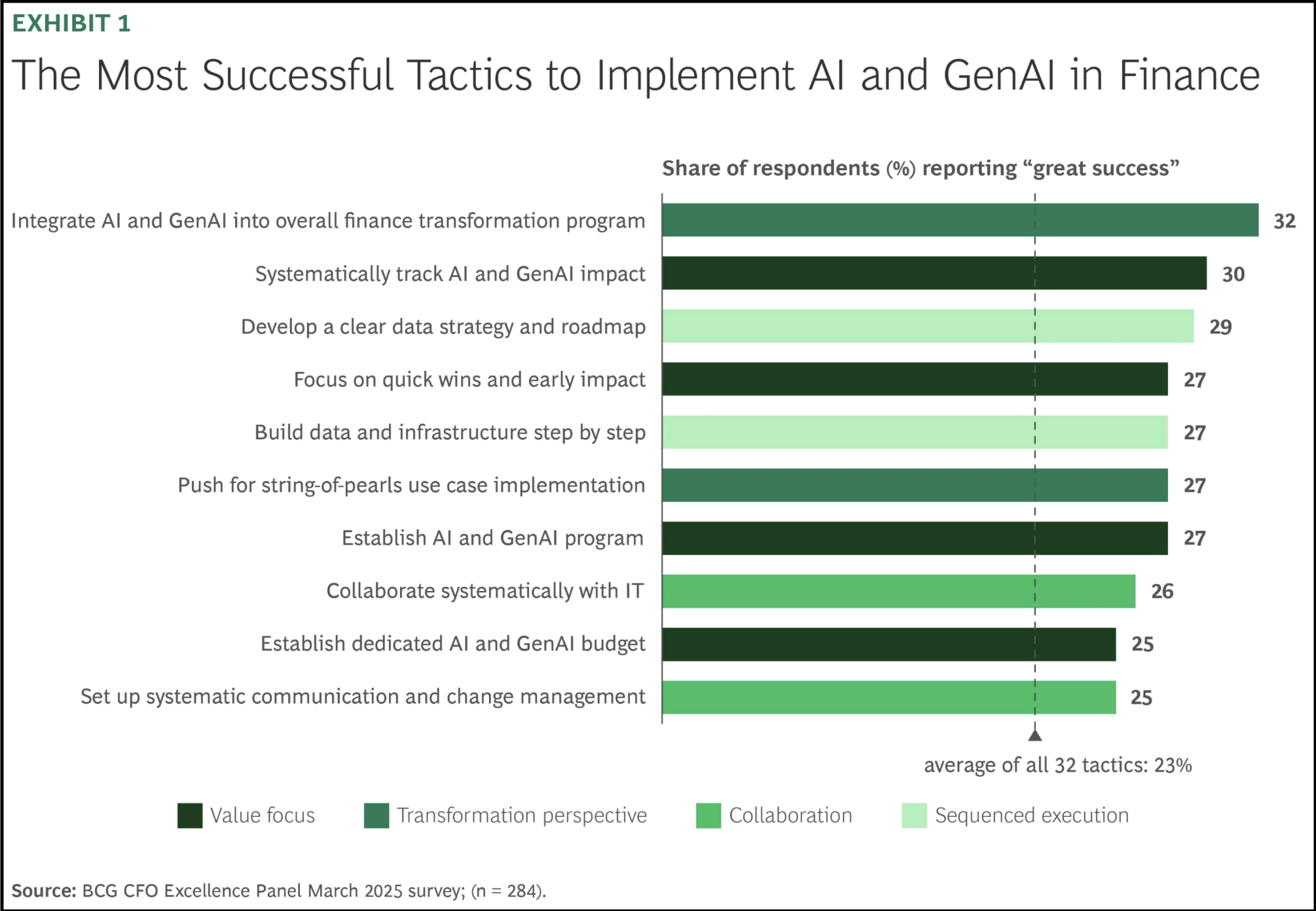
CFOs today are under pressure to do more than just manage numbers. They are expected to bring speed, clarity, and foresight into every financial decision. With markets moving fast and risks becoming harder to predict, traditional treasury processes often fall short. This is where Generative AI is making a difference.
Gen AI helps treasury teams make sense of large, scattered data without waiting for manual consolidation. It surfaces patterns across transaction histories, market inputs, and operational drivers to sharpen cash flow forecasts and speed up scenario exploration. It doesn’t replace core forecasting models, but it improves the way teams prepare and test assumptions.
The shift is clear: CFOs are not just testing AI in small pilots. They are scaling it across their treasury functions and building AI-first operations. In this blog, we’ll explore how they’re doing it—and what it means for the future of finance.
The Case for an AI-First Treasury
The CFO’s role has evolved beyond financial stewardship into a central force shaping enterprise strategy. Today’s finance leaders spend as much time on technology, talent, and innovation decisions as they do on traditional accounting and compliance. They are increasingly seen as co-pilots to the CEO, responsible for steering the organization through disruption and equipping it for growth.
Generative AI is emerging as one of the most powerful levers in this transformation. Early adopters report that AI improves the speed and quality of work by automating data checks, preparing draft analyses, and reducing back-and-forth during close. Teams rely on AI-driven validations to clean data upfront, which shortens cycle times and frees capacity for deeper analysis.
The business case has never been stronger. The cost of entry for AI pilots is relatively low, while the upside is significant: greater forecasting accuracy, faster scenario modeling, improved controls, Revenue impact is indirect and comes from better planning, improved pricing decisions, and tighter working capital management. The primary gains today are accuracy, speed, and consistency. New AI tools are proliferating across finance — from cash flow forecasting engines to automated narrative generators — and early results are encouraging. Many CFOs are already seeing measurable efficiency gains, error reduction, and better decision-support, with a growing number reporting direct revenue impact within the first year of adoption.
.jpg)
Perhaps the most compelling reason to act is the rising cost of inaction. AI is on a trajectory similar to cloud computing a decade ago: once considered experimental, now mission-critical. Recent industry surveys show finance is one of the fastest-growing areas for AI adoption, with a majority of organizations either using or actively implementing AI capabilities in planning, treasury, and risk management. Waiting on the sidelines risks leaving finance functions slower, more manual, and less competitive compared to peers who are moving fast to embed AI into their operations.
The message for CFOs is clear: leaning into AI is no longer optional. An AI-first treasury can transform finance from a back-office cost center into a forward-looking, insight-driven engine that supports better decisions and helps the enterprise navigate volatility with confidence.
Bridging the Gap Between Enthusiasm and Adoption
While interest is sky-high, actual deployment of AI in finance is still nascent. There is a noticeable gap between CFOs’ enthusiasm for AI and on-the-ground adoption. Bain’s end-of-2024 survey of 50 CFOs found that 71% were not yet using generative AI in their finance and accounting operations, despite the vast majority expressing interest and budget availability. CFOs are testing pilots, though only a subset has moved past proofs of concept. Most cite data readiness, integration effort, and governance concerns as reasons for caution. The hesitation isn’t about belief in AI’s value but about deploying it safely in a control-heavy environment.
This hesitation stems from practical challenges – some struggle to find solutions that truly meet their needs – as well as a healthy dose of caution.
CFOs are naturally cautious — risk management is central to their role. Finance teams work with highly sensitive data and operate under strict regulatory oversight, meaning a single AI-related error could have significant financial or compliance consequences. It’s no surprise that many CFOs see security and privacy as the biggest barriers to rapid adoption of AI.
This “trust gap” — the tension between AI’s promise and the potential for breaches or errors — is one of the primary reasons finance leaders have been measured in deploying AI solutions, especially those hosted in the cloud or provided by third parties. Rather than rejecting AI outright, CFOs are seeking to integrate it only when they can ensure robust safeguards are in place to protect data, guarantee accuracy, and meet compliance standards.
To bridge this gap, finance leaders are increasingly calling for “trusted AI” — solutions that offer built-in security, strong governance, and clear accountability. This includes insisting on auditable and explainable AI outputs, using private or highly secure cloud environments, and keeping a human in the loop for oversight of automated processes. The goal is to capture AI’s benefits without compromising trust, ensuring that every insight and action generated by AI can be verified and relied upon.
Generative AI Use Cases Transforming Finance
.jpg)
What does an “AI-first” treasury actually look like? Generative AI and machine learning are poised to reshape a wide range of finance and treasury activities. Here are some of the high-impact use cases where CFOs see potential:
- Financial Planning & Analysis (FP&A) and Forecasting: One of the biggest opportunities is using AI to enhance forecasting, budgeting and analytics. Unlike manual spreadsheet modeling, AI can rapidly crunch large, disparate datasets to identify patterns and project future outcomes. This enables more accurate forecasts that incorporate real-time inputs. CFOs are excited that AI can not only improve forecasts, but also explain the assumptions behind them – something traditional models struggled with. For example, gen-AI could automatically highlight why a revenue forecast changed (e.g. shifting market dynamics or input cost changes). According to Boston Consulting Group, advanced forecasting and risk analysis use cases tend to deliver the biggest business gains from AI – more so than basic task automation. In practice, AI-driven forecasting might cut cycle times by 30% and allow dynamic scenario modeling that was previously impractical manually.
- Cash Management and Treasury Operations: Treasury teams can leverage AI to optimize cash positioning, investments, and liquidity management in real time. AI models can analyze patterns in payables, receivables, and market data to produce more accurate cash forecasts and allocation decisions. An example is using AI to run Monte Carlo simulations on operational and market inputs to predict cash flow outcomes – something CFOs indicated would be valuable for better liquidity planning. Additionally, Modern ERP and treasury platforms ship with embedded AI features such as automated reconciliations, anomaly detection, and conversational search across financial data. These tools assist by preparing drafts or suggesting matches. Final approvals and cash movements remain under existing maker-checker controls. While this area is emerging, leading ERP and treasury software vendors are embedding AI capabilities into their platforms. For instance, SAP’s newest software includes AI “agents” that can draft financial reports, match payments, and respond to queries via a chatbot. As these built-in tools mature, treasury departments can gain AI benefits with minimal custom development.
- Accounts Payable, Procurement and Expense Management: These document- and process-intensive workflows are ripe for AI-driven automation. Early adopter CFOs have already seen wins here. Gen-AI can read invoices, purchase orders, and receipts to automate coding, approvals, and anomaly detection. In one case, a finance team built a custom AI workflow to identify vendor details and prepare journal entries for payables – cutting a month-end AP closing process from 20 hours down to just 2 hours. Others are using AI (and even ChatGPT) to streamline expense report auditing and contract reviews. These efficiency gains free up staff time and reduce errors. It’s no surprise that accounts payable and procure-to-pay are among the top areas where CFOs are seeking AI solutions. By automating repetitive tasks like invoice processing, finance teams can reallocate effort to more strategic activities.
- Risk Management and Compliance: Finance leaders must ensure that AI augments their control environment, not weakens it. Fortunately, AI can be a powerful ally in risk management. Machine learning algorithms are adept at scanning transactions or entries to flag anomalies and potential fraud, strengthening financial controls. AI can also help with compliance by monitoring transactions against regulatory requirements and performing rapid due diligence checks. For example, AI can scan large volumes of records for inconsistencies, policy breaches, or patterns that warrant review. It accelerates coverage and reduces manual effort, while final judgments remain with analysts and auditors. These capabilities can significantly reduce the manual burden of compliance and audit prep. Of course, CFOs will still demand that any AI used in this domain is explainable and auditable – underscoring the importance of robust governance (addressed later in the playbook).
- Financial Reporting and Narrative Generation: AI can draft early versions of management commentary, flux explanations, or variance narratives by summarizing the underlying numbers. Finance teams validate the logic, adjust the language, and ensure compliance with accounting standards. While humans must review and refine these outputs, they provide a solid starting point, saving time. Generative AI can also personalize reports for different stakeholders, highlighting the most relevant insights for each. This use of AI not only improves efficiency but can also lead to better communication of financial results and drivers.
- Data Management and Decision Support: A less glamorous but vital use of AI is it helps detect issues, surface anomalies, and enrich datasets, but data engineering pipelines do the heavy lifting for consolidation and validation. With automated ingestion and checks in place, AI adds context and flags problems earlier. With a solid data foundation, AI and analytics tools can then surface insights that inform strategic decisions – from identifying cost outliers to predicting customer profitability. Some CFOs envision AI “agents” that continuously monitor business metrics and alert the team to emerging issues or opportunities. In practice, this means finance can shift from reactive reporting to proactive insight generation.
Early Wins and ROI: What CFOs Are Seeing
.jpg)
Despite the excitement surrounding AI, many CFOs are still asking a practical question: Is it really paying off? The answer so far is nuanced — significant benefits are possible, but they are not automatic. Many early pilots have been experimental or misaligned with the most critical business priorities, leading to modest or difficult-to-measure ROI. This reinforces the need for a deliberate, well-structured strategy for scaling AI in finance.
That said, the upside can be substantial when AI projects are executed well. Finance teams that have automated time-consuming processes, such as accounts payable or reconciliations, report saving hundreds of hours annually. Others highlight that AI has dramatically accelerated analysis, allowing teams to deliver insights faster without reducing headcount. In forecasting, AI-powered models can analyze far more drivers and scenarios than a human team could manually, producing more robust and timely projections. The impact varies widely based on data quality and use case maturity. Efficiency gains are the easiest to quantify. Forecasting improvements depend heavily on data depth and model design, so finance teams track error rates and cycle times instead of relying on generic industry benchmarks.
Survey data from early adopters shows encouraging results: the majority of CFOs using generative AI report significant efficiency gains, with many also seeing improved accuracy and error reduction. These improvements flow straight to the bottom line through lower costs, reduced rework, and better decisions. A growing share are even reporting direct revenue impact, thanks to improved pricing insights, more accurate demand forecasting, or better capital allocation. Beyond the hard metrics, CFOs cite softer benefits like higher team morale — as mundane tasks are automated — and the ability to redirect capacity toward strategic initiatives.
Crucially, the largest payoffs come when AI is applied to business-critical levers rather than isolated process automation. Projects that improve forecasting accuracy, strengthen risk management, or inform capital allocation decisions tend to deliver outsized value compared to automating narrow tasks. Efficiency is often the first benefit realized, but the ultimate prize lies in better insights and smarter decisions that shape the trajectory of the business.
To capture that value, CFOs must measure outcomes rigorously. Many admit that quantifying the impact of AI — particularly on qualitative benefits like insight quality — is challenging. The most successful teams define clear success metrics upfront: reduction in manual hours, improvements in forecast error rates, faster close times, or improved scenario-response speed. They track these indicators continuously and use them to decide where to double down and where to pivot. In doing so, they treat AI investments with the same rigor as any other major capital initiative — funding what works, cutting what doesn’t, and keeping a clear line of sight to ROI.
The CFO’s Playbook: Strategies for Scaling AI Adoption
According to a BCG survey, the most successful finance AI initiatives share common tactics (see chart above). CFOs should craft their AI adoption playbook with these principles in mind:

1. Focus on High-Value Use Cases and Quick Wins
Not every AI initiative will move the needle, so CFOs must start where impact is most tangible. Prioritize use cases that directly drive business outcomes rather than chasing open-ended experiments. The best-performing finance teams target projects that save significant time, reduce errors, or improve decision-making — for example, automating a painful close process, accelerating cash forecasting, or improving risk models. Quick wins create momentum, prove value, and secure buy-in for broader investments. Every AI initiative should have clear, measurable outcomes tied to cost reduction, time saved, risk mitigation, or revenue uplift. Define success criteria upfront — e.g., “reduce monthly close by two days” or “improve forecast accuracy by 20%” — and track progress rigorously. Treat AI like any other investment: measure results, double down on what works, and pivot quickly if value isn’t being delivered.
2. Embed AI Into the Broader Finance Transformation
AI initiatives should not exist in isolation. They are most successful when integrated into a cohesive finance modernization roadmap. Start with a clear vision of the “future-state finance function” and position AI as a series of connected steps toward that destination. Leading organizations use a “string-of-pearls” approach — linking use cases in sequence so each builds on the data, processes, and skills established by the last. For example, automate data consolidation first, then use that clean dataset to enable AI forecasting, then layer scenario modeling on top. This sequencing yields compounding benefits, encourages end-to-end process redesign, and ensures AI becomes part of the fabric of how finance operates — not a standalone experiment.
3. Invest in Data Foundations and Governance
AI is only as good as the data and controls that support it. Break down silos, clean and standardize data, and establish infrastructure to feed models with accurate, timely inputs. Work closely with technology teams to automate data pipelines so finance isn’t manually wrangling numbers. In parallel, build governance into AI from day one: Governance centers on data lineage, model validation, explainability, access controls, and auditability. Finance teams document how models are used, what checks exist, and how results should be interpreted so AI stays aligned with existing controls.
Auditability is essential — finance must be able to explain and trust every number, including those generated by AI. Establish validation checkpoints and document AI-driven decisions to avoid downstream issues. Finally, address privacy and compliance concerns head-on, ensuring AI solutions meet regulatory standards (e.g., GDPR) and internal policies. Consider forming an AI governance committee and favor “trusted AI” solutions with proven security features.
4. Start Small, Then Scale Deliberately
Trying to tackle too many use cases at once is a common failure point. Begin with focused pilots that have clear objectives, then use the results to refine the strategy and secure wider buy-in. Create a small, dedicated team responsible for running AI experiments and tracking their outcomes. Choose pilot projects that can scale across the organization if successful, and build flexible architecture that supports future growth. Avoid the trap of “successful pilot, stagnant rollout” by having a deployment plan in place from the start. Each phase of the roadmap should deliver concrete business value while laying the groundwork for the next — systematically transforming finance without overwhelming teams or systems.
5. Collaborate and Cultivate Talent
AI success in finance is a cross-functional effort. Partner closely with IT and data teams to align on data architecture, tools, and security protocols. Consider leveraging external vendors or technology partners to fill skill gaps or accelerate time-to-value, especially given the shortage of AI talent. Many CFOs discover that their ERP and finance software already include underutilized AI features — from chatbots that assist with reporting to automated reconciliation tools — that can deliver quick results. Reserve custom-built models for areas that provide a genuine competitive advantage, such as proprietary forecasting algorithms or unique risk models.
6. Champion Culture Change and Upskilling
Technology alone won’t transform finance — people will. CFOs must actively foster an AI-ready culture by addressing fears and positioning AI as a tool to augment, not replace, human talent.
Focus on building AI literacy across the team. People need to understand how AI works, where it helps, and how to interpret outputs. The goal isn’t to turn finance staff into data scientists but to help them use AI responsibly. Provide education on how models work, their limitations, and how to interpret results so employees can confidently use AI outputs. Support this with structured change management, regular updates, and stakeholder engagement to drive adoption and avoid resistance.
Wrapping it up!
Generative AI is no longer a side experiment for finance leaders — it’s becoming a core enabler of strategic decision-making and operational excellence. CFOs who embrace AI with a structured, value-driven approach are transforming treasury from a back-office cost center into a proactive, insight-driven engine that shapes business outcomes. By prioritizing high-impact use cases, embedding AI into broader transformation efforts, and building trust through data governance and explainability, they are proving that AI can deliver measurable results without compromising control.
The path forward is clear: start small, learn quickly, and scale deliberately. Pair technology with talent, communicate wins to build confidence, and keep ROI at the center of every initiative. CFOs who lead this change will not only improve efficiency and forecasting accuracy but also position their organizations to act faster, manage risk better, and compete more effectively in an increasingly complex financial landscape. The opportunity is here — the leaders who act decisively today will define what an AI-first treasury looks like tomorrow.





.png)





.png)




.png)
.svg)


